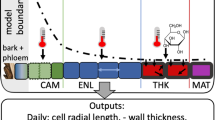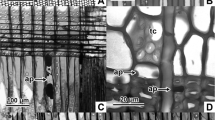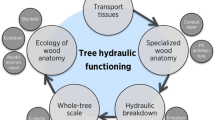Abstract
We apply a recent model of wood grain pattern formation to the junction between two tree branches. In model simulations, the export of indole-3-acetic acid (IAA) from a branch into the junction is necessary to maintain the continuity between the grain pattern of the branch and the grain of the subjacent stem. Increased IAA export corresponds to a larger effect on the overall grain pattern. Conversely, if IAA export stops, the grain pattern diverts around the branch. These results do not depend on specific values for the model parameters and appear to be quite general. Since long-range water transport is largely parallel to the wood grain, greater IAA export from a branch is expected to give improved access to the water resources of the tree. IAA export thus emerges as a likely regulator of branch vigor. In this way, the basipetal flux of IAA through a branch, and its morphological consequences at branch junctions, may play an important role in several aspects of tree form.









Similar content being viewed by others
References
Aloni R, Alexander JD, Tyree MT (1997) Natural and experimentally altered hydraulic architecture of branch junctions in Acer saccharum Marsh. and Quercus velutina Lam. trees. Trees 11:255–264
Aloni R, Schwalm K, Langhans M, Ullrich C (2003) Gradual shifts in sites of free-auxin production during leaf-primordium development and their role in vascular differentiation and leaf morphogenesis in Arabidopsis. Planta 216:841–853
Aloni R, Zimmermann MH (1983) The control of vessel size and density along the plant axis: a new hypothesis. Differentiation 24:203–208
Andre JP (2000) Heterogeneous, branched, zigzag and circular vessels: unexpected but frequent forms of tracheary element files: description—localization—formation. In: Savidge RA, Barnett J, Napier R (eds) Cell and molecular biology of wood formation. BIOS Scientific, Oxford, pp 284–293
Becker P, Meinzer FC, Wullschleger SD (2000) Hydraulic limitation of tree height: a critique. Funct Ecol 14:4–11
Brooks J, Schulte P, Bond B, Coulombe R, Domec J-C, Hinckley TM, McDowell N, Phillips N (2002) Does foliage on the same branch compete for the same water? Experiments on Douglas-fir trees. Trees 17:101–108
Brown C, McAlpine R, Kormanik P (1967) Apical dominance and form in woody plants: a reappraisal. Am J Bot 54:153–162
Catesson AM (1990) Cambial cytology and biochemistry. In: Iqbal M (ed) The vascular cambium. Wiley, New York
Cline MG (1997) Concepts and terminology of apical dominance. Am J Bot 84:1064–1069
Eisner N, Gilman E, Grabosky J (2002a) Branch morphology impacts compartmentalization of pruning wounds. J Arboric 28:99–105
Eisner N, Gilman E, Grabosky J, Beeson R (2002b) Branch junction characteristics affect hydraulic segmentation in red maple. J Arboric 28:245–251
Ellmore GS, Ewers FW (1986) Fluid flow in the outermost xylem increment of a ring-porous tree, Ulmus americana. Am J Bot 73:1771–1774
Foley C (2001) A three-dimensional paradigm of fiber orientation in timber. Wood Sci Technol 35:453–465
Funada R, Sugiyama T, Kubo T, Fushitani M (1987) Determination of indole-3-acetic acid levels in Pinus densiflora using the isotope dilution method. Mokuzai Gakkaishi 33:83–87
Funada R, Mizukami E, Kubo T, Fushitani M, Sugiyama T (1990) Distribution of indole-3-acetic acid and compression wood formation in the stems of inclined Cryptomeria japonica. Holzforschung 44:331–334
Funada R, Kubo T, Sugiyama T, Fushitani M (2002) Changes in levels of endogenous plant hormones in cambial regions of stems of Larix kaempferi at the onset of cambial activity in springtime. J Wood Sci 48:75–80
Funada R, Kubo T, Tabuchi M, Sugiyama T, Fushitani M (2001) Seasonal variations in endogenous indole-3-acetic acid and abscisic acid in the cambial region of Pinus densiflora Sieb. et Zucc. stems in relation to earlywood-latewood transition and cessation of tracheid production. Holzforschung 55:128–134
Goulet J, Messier C, Nikinmaa E (2000) Effect of branch position and light availability on shoot growth of understory sugar maple and yellow birch saplings. Can J Bot 78:1077–1085
Green DW, Winandy JE, Kretschmann DE (1999) Mechanical properties of wood handbook: wood as an engineering material. Forest products laboratory, USDA Forest Service, Madison, Wis.
Harris JM (1969) On the causes of spiral grain in corewood of radiata pine. N Z J Bot 7:189–213
Harris JM (1989) Spiral grain and wave phenomena in wood formation. Springer, Berlin Heidelberg New York
Henriksson J (2001) Differential shading of branches or whole trees: survival, growth, and reproduction. Oecologia 126:482–486
Iqbal M, Ghouse AKM (1990) Cambial concept and organization. In: Iqbal M (ed) The vascular cambium. Wiley, New York, pp 1–28
Kirschner H, Sachs T, Fahn A (1971) Secondary xylem reorientation as a special case of vascular tissue differentiation. Isr J Bot 20:184–198
Kozlowski TT, Winget CH (1963) Patterns of water movement in forest trees. Bot J 124:301–311
Kramer EM (2002) A mathematical model of pattern formation in the vascular cambium of trees. J Theor Biol 216:147–158
Kramer EM, Groves JV (2003) Defect coarsening in a biological system: the vascular cambium of cottonwood trees. Phys Rev E 67:041914
Larson PR (1994) The vascular cambium. Springer, Berlin Heidelberg New York
Lev-Yadun S, Aloni R (1990) Vascular differentiation in branch junctions of trees: circular patterns and functional significance. Trees 4:49–54
Mattheck C, Kubler H (1995) Wood: the internal optimization of trees. Springer, Berlin Heidelberg New York
Nikinmaa E, Messier C, Sievanen R, Pettunen J, Lehtonen M (2003) Shoot growth and crown development: effect of crown position in three-dimensional studies. Tree Physiol 23:129–136
Phillips GE, Bodig J, Goodman JR (1981) Flow-grain analogy. Wood Sci 14:55–64
Powers SJ, Brain P, Barlow PW (2003) First-order differential equation models with estimable parameters as functions of environmental variables and their application to a study of vascular development in young hybrid aspen stems. J Theor Biol 222:219–232
Rudinsky JA, Vite JP (1959) Certain ecological and phylogenetic aspects of the pattern of water conduction in conifers. For Sci 5:259–266
Ryan MG, Yoder BJ (1997) Hydraulic limits to tree height and tree growth. Bioscience 47:235–242
Savidge RA (1996) Xylogenesis, genetic and environmental regulation. IAWA J 17:269–310
Schulte P, Brooks J (2003) Branch junctions and the flow of water through xylem in Douglas-fir and ponderosa pine stems. J Exp Bot 54:1597–1605
Shigo AL (1985) How tree branches are attached to trunks. Can J Bot 63:1391–1401
Shigo AL (1991) Modern arboriculture. Shigo and Trees Association, Durham, N.H.
Sperry JS, Hacke UG, Oren R, Comstock JP (2002) Water deficits and hydraulic limits to leaf water supply. Plant Cell Environ 25:251–263
Sprugel DG (2002) When branch autonomy fails: Milton’s Law of resource availability and allocation. Tree Physiol 22:1119–1124
Sprugel DG, Hinckley TM, Schapp W (1991) The theory and practice of branch autonomy. Annu Rev Ecol Syst 22:309–334
Stoll P, Schmid B (1998) Plant foraging and dynamic competition between branches of Pinus sylvestris in contrasting light environments. J Ecol 86:934–945
Sundberg B, Ericsson A, Little CHA, Nasholm T, Gref R (1993) The relationship between crown size and ring width in Pinus sylvestris L. stems: dependence on indole-3-acetic acid, carbohydrates, and nitrogen in the cambial region. Tree Physiol 12:347–362
Sundberg B, Uggla C (1998) Origin and dynamics of indoleacetic acid under polar transport in Pinus sylvestris. Physiol Plant 104:22–29
Sundberg B, Uggla C, Tuominen H (2000) Cambial growth and auxin gradients. In: Savidge RA, Barnett J, Napier R (eds) Cell and molecular biology of wood formation. BIOS Scientific, Oxford, pp 169–188
Takenaka A (2000) Shoot growth responses to light microenvironment and correlative inhibition in tree seedlings under a forest canopy. Tree Physiol 20:987–991
Tuominen H, Peuch L, Fink S, Sundberg B (1997) A radial concentration gradient of indole-3-acetic acid is related to secondary xylem development in Populus. Plant Physiol 115:577–585
Tuominen H, Puech L, Regan S, Fink S, Olsson O, Sundberg B (2000) Cambial region specific expression of the Agrobacterium iaa genes in transgenic aspen visualized by a linked uidA reporter gene. Plant Physiol 123:531–541
Tyree MT, Alexander JD (1993) Hydraulic conductivity of branch junctions in three temperate tree species. Trees 7:156–159
Tyree MT, Ewers FW (1991) The hydraulic architecture of trees and other woody plants. New Phytol 119:345–360
Uggla C, Moritz T, Sandberg G, Sundberg B (1996) Auxin as a positional signal in pattern formation in plants. Proc Natl Acad Sci USA 93:9282–9286
Uggla C, Mellerowicz E, Sundberg B (1998) Indole-3-acetic acid controls cambial growth in Scots pine by positional signalling. Plant Physiol 117:113–121
Zagorska-Marek B, Little CHA (1986) Control of fusiform initial orientation in the vascular cambium of Abies balsamea stems by indole-3-ylacetic acid. Can J Bot 64:1120–1128
Zimmermann MH, Brown C (1971) Trees: structure and function. Springer, Berlin Heidelberg New York
Acknowledgements
We are grateful to Simon’s Rock College for the support of this research through the provision of a Faculty Development Fund and student research internships.
Author information
Authors and Affiliations
Corresponding author
Appendices
Appendix 1. Model equations
In this appendix we discuss the differential equations used in our model of wood grain at a branch junction. We begin with Eqs. 1 and 2 from Kramer and Groves (2003) and use their notation. The model is a pair of coupled, nonlinear partial differential equations in the variables m and u, where m is the local mass of IAA per unit area of cambial surface and u is the local grain direction. The equations as cited have been transformed to the dimensionless variables \({\mathbf{{r}'}} = {\mathbf{r}}v/D_{\parallel } \), \({t}' = tK(v/D_{\parallel } )^{2} \), and \({m}' = m/\langle m\rangle \), where 〈m〉 is a characteristic IAA concentration (we use the value m=m 1 imposed at the top of the simulation domain). Since we are seeking time-independent solutions, we set ∂m/∂t=0 and ∂u/∂t=0. Dropping all primes gives:
Following Kramer and Groves (2003), we set r D =0.23 and L=0.5 for all the simulations reported in this paper. This leaves just one dimensionless parameter of interest, \(\lambda = Kv/(\mu D_{\parallel } m_{1} )\).
Appendix 2. Boundary conditions
Separate from the model equations that dictate the solution in the interior of the simulation domain (see Appendix 1), one also needs to specify the shape of the domain and the boundary conditions on m and u. As shown in Fig. 4, we use a square simulation domain of side S, with an disk of radius R excised from the center.
Fluxes There is a uniform flux of IAA into the domain at the top edge of the square and a second flux into the domain at the edge of the disk. These two fluxes represent the IAA supplied by the two distal branches. There is an IAA sink along the bottom edge that allows IAA to drain out of the domain via active transport. Side-to-side the domain has periodic boundary conditions, which is to say that IAA exiting the domain along the right edge immediately re-enters on the left and vice versa. This is not a necessity, but it is a useful means to enforce IAA conservation.
To set the apical flux, we impose the conditions m=m 1 and ∂m/∂y=0. The net flux into the domain through the top edge is thus Φ 1=m 1 vS. Implementing the flux at the circular boundary was nontrivial. Rather than imposing a condition at the boundary per se, we include the disk as part of the simulation domain. At each time step, every lattice site in the disk is given a small additional mass of IAA, Δm. The direction of active transport at all lattice sites in the disk is chosen to be radially outward, so that all mass deposited in the disk eventually exits the disk. The value of Δm is chosen so the net flux out of the disk is Φ 2.
Grain The grain direction along the top and side edges of the square domain is chosen to point downward (u=−e y). We impose the Neumann condition ∂u/∂y=0 at the bottom edge. The condition on u at the boundary of the disk is again problematic. Since we want the flux of IAA to point radially outward, we originally chose u=e r on the disk boundary. While this works fine for λ<1, it causes problems when the grain stiffness is too large. In particular, it leads to an anomalously large region of approximately radial grain outside the disk. The fix for this problem was to recognize that the direction of IAA active transport in the disk could be uncoupled from the value for u as it appears in the calculation of the Laplacian (see Eq. 2, Appendix 1). We then set u=0 at the boundary of the disk.
Rights and permissions
About this article
Cite this article
Kramer, E.M., Borkowski, M.H. Wood grain patterns at branch junctions: modeling and implications. Trees 18, 493–500 (2004). https://doi.org/10.1007/s00468-004-0322-2
Received:
Accepted:
Published:
Issue Date:
DOI: https://doi.org/10.1007/s00468-004-0322-2




